Home
A comprehensive resource for safe and responsible laser use
US: FAA data shows lower numbers for 2015 and other years
The original, higher figure came from the December 31 2015 FAA Laser Report. This spreadsheet of laser incidents had 7,703 rows with each row listing one laser illumination report.
In January 2016, researcher Dr. Todd Curtis cleaned up the list and found 7,676 valid reports. (The clean-up criteria is not known.)
The FAA's new, lower number of 7,346 reports was first noticed by LaserPointerSafety.com in an April 10 2019 fact sheet released by FAA. The agency has a separate page with Microsoft Excel spreadsheets listing reported laser incidents for 2010 through 2018. The spreadsheet now online for 2015 has only 7,346 reports — not the 7,703 reports of the original December 31 2015 FAA spreadsheet.
LaserPointerSafety.com has analyzed some of the dropped reports. A few may be duplicates, but many appear to be valid reports dropped for an unknown reason.
LaserPointerSafety.com believes that the original 7,703 figure is closer to the actual number of laser illumination reports submitted by pilots in 2015. However, for consistency, as of May 5 2019, LaserPointerSafety.com is using the new April 2019 FAA numbers on various pages such as the Laser/aircraft illumination statistics page.
Note that there may be some website pages and some articles, scientific papers, etc. outside of the website which reference the original, pre-April 2019 numbers.
Changed numbers also for 2007, 2008, 2016 and 2017
The number of laser incidents reported in other years has also changed:
- 2007 was originally listed as having 639 reports; in April 2019 FAA said there were 590 reports.
- 2008 was originally listed as having 949 reports; in April 2019 FAA said there were 913 reports.
- 2016 was originally listed as having 7,442 reports; in April 2019 FAA said there were 7,398 reports.
- 2017 was originally listed as having 6,753 reports; in April 2019 FAA said there were 6,754 reports.
UK: 200+ laser pen injuries illustrate the risk to children, especially with behavioral problems
The study looked at 77 case reports of laser eye injuries in children. In four of the cases there were reported psychological or behavioral issues.
In addition, the authors had experience with four children with laser eye injuries; in three of these cases there were psychological or behavioral issues.
One of the authors sent a survey to 990 consulting ophthalmologists in the U.K. This found 159 cases of macular injury due to "misuse of a handheld laser device," with 80% of those injured being children or teenagers. In 35% of the cases, the injury was self-inflicted; in 36% it was caused by a third-party. (The remaining 29% seem to be uncategorized although the paper notes that "there were no cases of assault reported." In 67% of the cases where the laser power was known, it was under 50 milliwatts.
The paper cautions that the actual number of laser injuries seen by the ophthalmologists may be higher: "A limitation was the poor response rate and thus data so obtained do not provide the true incidence and clinical features of such cases."
Click to read more...
Canada: Study first to show prevalence of laser use, injuries among general public
It showed that 48 percent of Canadians over the age of 12 either used or were exposed to lasers, annually.
Of those who reported using a laser product, 1.1% reported discomfort or injury.
[LaserPointerSafety.com analysis: Based on 2016 Canadian census data, there were 29,312,165 Canadians age 15 or older — data was not available on age 12+. If 48% of these 29 million Canadians used or were exposed to lasers, that would be just over 14 million people. If 1.1% of them experienced discomfort or injury, that would be about 155,000 Canadians with laser discomfort or injury.]
Returning to the Statistics Canada study, of the discomfort/injury cases:
- 41% were for skin injuries "such as rash, itch or pain," while 59% were for eye injuries "such as itchiness, pain, visible floating objects, blurred vision, burn, flash blindness, excessive watering or loss of sight."
- In 64% of cases, the discomfort or injury lasted less than two days; in 34%, it lasted more than two days.
- The discomfort/injury was caused by the person's own use of the laser in 25% of cases, and by someone else's use in 75% of cases.
- 39% of the discomfort/injury cases were caused by cosmetic treatments, 26% were caused due to laser pointers, and 34% were caused by "other" which included surveying tools, entertainment lasers, materials processing, and scanners.
The study analyzed published eye injury case reports since 1999, and concluded:
"…the majority involved the misuse of a handheld battery-operated laser product by an adult or a child. Most of these injuries were the result of irresponsible use or deliberate staring at a laser by a child, or the result of the inappropriate use of a high-powered laser device (Class 3B or 4) in an 'uncontrolled environment'....In the cases reported in 2014 that included long-term follow-up injury reporting, about one-half of the ocular injuries resolved within one to two weeks, with the other 50% of patients sustaining longer-term visual impairments."
Click to read more...
US: MIT develops laser to deliver secret audio messages
Their paper describing this, "Photoacoustic communications: delivering audible signals via absorption of light by atmospheric H₂O", was published in January 2019. The abstract is as follows:
We describe a means of communication in which a user with no external receiver hears an audible audio message directed only at him/her. A laser transmits the message, which is encoded upon a modulated laser beam and sent directly to the receiver’s ear via the photoacoustic effect. A 1.9 μm thulium laser matched to an atmospheric water vapor absorption line is chosen to maximize sound pressure while maintaining eye-safe power densities. We examine the photoacoustic transfer function describing this generation of audible sound and the important operational parameters, such as laser spot size, and their impact on a working system.
The laser is said to be eye- and skin-safe. The system can currently send a sound up to 60 dB across a distance of 2.5 meters (8 feet). In the future they are hoping for a range of 100-500 meters (328-1,640 feet). It is useful for applications as diverse as notifying one person in a crowd, and for headphone-free listening. MIT is patenting the technology.
From R. Sullenberger, S. Kaushik, and C. Wynn, "Photoacoustic communications: delivering audible signals via absorption of light by atmospheric H₂O," Opt. Lett. 44, 622-625 (2019). A PDF of the article is here. News stories about this appeared in numerous publications including Digital Trends, Photonics.com and The Sun.
US: Low-cost malaria detector uses a laser pointer and a magnet
The portable device is about the size of a toaster. It “has been made simple enough to be used by everyone and is also compact and rugged so that it can be shipped worldwide.”
One of the principal researchers is working on making this commercially available.
Popular press account at CrazyEngineers.com. Scientific paper published May 21 2018: Rapid Diagnostic for Point-of-Care Malaria Screening, Samantha E. McBirney, Dongyu Chen, Alexis Scholtz, Hossein Ameri, and Andrea M. Armani, ACS Sensors Article ASAP, DOI: 10.1021/acssensors.8b00269
Scotland: Scientists develop way to shoot laser light from eyes
The team from the University of St. Andrews demonstrated the new technology by putting a membrane laser onto a standard contact lens (photo a below), then placing this on a cow’s eye (photos b and c). A cow’s eye is similar to human eyes and is widely available as a byproduct of meat processing. The researchers then illuminated the eye with safe pulsed blue light (“Pump” in photo d) and “observed a well-defined green laser beam emerging from the eye” (“Far field emission” in photo d).
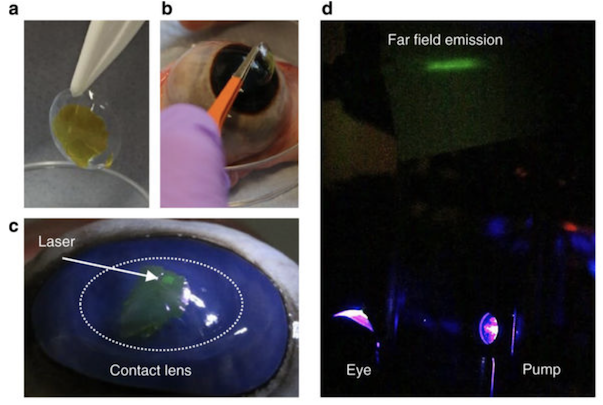
The diagram below shows the narrow wavelength of the emitted light (emission power on the left-hand scale is in “arbitrary units”).
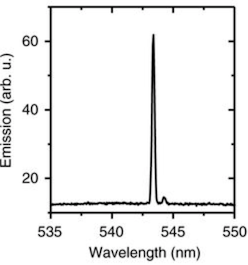
The pump light minimum fluence to cause lasing was 58,800 W/cm², which is about one order of magnitude less than the maximum power density permitted by the ANSI 2000 standard for intentional and repeated ocular exposure. The researchers state that “a membrane laser on a contact lens could thus—under appropriate pumping conditions—be safely operated while being worn in the eye.”
Applications of the membrane laser include use as a security device affixed to banknotes or the human body (researchers also put a laser on a fingernail). A pumping beam is shone onto the substrate (banknote, eye, fingernail) to see if laser light of the expected wavelength is emitted. In the future, “[f]urther optimization of the DFB grating will likely allow lower lasing thresholds and facilitate LED pumping of membrane lasers. By combining recently developed roll-to-roll nanoimprint and organic ink jet printing technology, membrane lasers could be mass-produced with high reproducibility and at low cost.”
The researchers’ paper received widespread publicity, often with photos such as the one below. However, one of the authors, Prof. Malte Gather told the Express, “When we thought about this idea of making the laser membrane, someone suggested it was the first step towards making Superman real. It was meant as a joke but I thought it could be serious after all in certain applications. What is important for a normal human – not being Superman – is that our lasers are extremely efficient and hence can emit laser light that is not very bright. That excludes it from being used as a weapon but means that you could put it on to your eye without blinding yourself.”

From Nature Communications, volume 9, Article number: 1525 (2018), doi:10.1038/s41467-018-03874-w, available online here. Press release from University of St. Andrews. Typical popular press stories from U.S. News, USA Today, and the Express. A more detailed, science-oriented summary and discussion is from Optics and Photonics.
Germany: Scientific study of laser pointer eye injuries finds 111 cases
Background: Recent years have seen a marked increase in laser-pointer-related injuries, which sometimes involve severe retinal damage and irreversible visual impairment. These injuries are often caused by untested or incorrectly classified devices that are freely available over the Internet.
Methods: We reviewed pertinent publications retrieved by a systematic search in the PubMed and Web of Science databases and present our own series of clinical cases.
Results: We identified 48 publications describing a total of 111 patients in whom both acute and permanent damage due to laser pointers was documented. The spectrum of damage ranged from focal photoreceptor defects to macular foramina and retinal hemorrhages associated with loss of visual acuity and central scotoma. On initial presentation, the best corrected visual acuity (BCVA) was less than 20/40 (Snellen equivalent) in 55% of the affected eyes and 20/20 or better in 9% of the affected eyes. Treatment options after laser-pointer-induced ocular trauma are limited. Macular foramina and extensive hemorrhages can be treated surgically. In our series of 7 cases, we documented impaired visual acuity, central visual field defects, circumscribed and sometimes complex changes of retinal reflectivity, and intraretinal fluid. Over time, visual acuity tended to improve, and scotoma subjectively decreased in size.
Conclusion: Laser pointers can cause persistent retinal damage and visual impairment. In view of the practically unimpeded access to laser pointers (even high-performance ones) over the Internet, society at large now needs to be more aware of the danger posed by these devices, particularly to children and adolescents.
From Birtel J, Harmening WM, Krohne TU, Holz FG, Charbel Issa P, Herrmann P. Retinal injury following laser pointer exposure—a systematic review and case series. Dtsch Arztebl Int, 2017 DOI: 10.3238/arztebl.2017.0831. Original in German, translation in English.
Australia: Study shows laser pointers are #2 cause of pilot incapacitation
There were 113 flight crew incapacitations in Australia during the study period — an average of about 23 per year. Of these, 15 (13.3%) of the reported incapacitations were due to laser strikes.
The study looked at “high-capacity” and “low-capacity” air transport, as well as general aviation.
During the study period there were 1,316 laser strikes reported to the ATSB in high-capacity operations. Of these, eleven (0.8%) of the laser strikes resulted in flight crew incapacitation.
A summary of the ATSB study is here. The full 30-page PDF document is available online from ATSB or from a local copy here at LaserPointerSafety.com.
US: Survey paper says "Injury from laser pointer trauma is a public health problem on the rise"
It begins by summarizing misuse in sports, and in the thousands of incidents per year in the U.S. where lasers are aimed at aircraft.
The authors, Dr. Gregory D. Lee and Dr. David R. Lally, then write “Perhaps the greatest concerns are raised by reports of unsupervised children who have received these lasers as toys or gifts and expose themselves to the laser beams, causing permanent retinal injury with reduced central vision. From 2000 to 2009, there were five reports of 18 patients with injuries due to laser pointer exposure.”
They discuss the types of injuries (thermal, photochemical and mechanical) and locations of retinal injuries. There is a listing of laser classes, with “pointers” — Class 1, 2 or 3R (IIIa) — being distinguished from similar-looking but more powerful Class 3B and 4 “handheld” lasers.
The authors conclude as follows:
“Inappropriately used class 3B or 4 lasers should be considered weapons that can cause serious, permanent bodily injury. Even brief exposures to diffused rays of laser beams can cause temporary flash blindness that may last for hours in airline pilots, endangering the lives of passengers, particularly during takeoff and landing sequences. Cases of short-range laser exposure are becoming more common, often involving children who are inappropriately given these devices as toys, and these patients are referred to retina specialists after the damage has already occurred.
“No definitive experimental study, case report, or animal model has shown improvement in these injuries with any type of treatment, but typically these patients are treated with a short course of corticosteroids or nonsteroidal antiinflammatory drugs. Secondary choroidal neovascularization has been treated successfully with intravitreal anti-VEGF agents.13,14
“Clinicians, particularly retina specialists, can raise awareness of this rising public health issue by educating patients and parents about the hazards of laser pointers. Legislation is currently being written to impose stronger regulations on the distribution and sale of these devices. If a patient presents with findings of a laser-related retinal injury, clinicians should report the incident to the FDA so that investigations can be performed into the manufacturers of these devices. Reports can be made at www.fda.gov/downloads/AboutFDA/ReportsManualsForms/Forms/UCM236066.pdf.”
From Retina Today
US: Student develops experimental laser location detection device
The system is intended for use in cockpits, and is self-contained — it does not need to interface with any aircraft instruments. For location, altitude and orientation data, it has a GPS and a 3-axis magnetic compass.
A laser is detected by a camera sensor, currently with 1024 x 1024 pixel resolution. The camera detects the bright “bloom” from a direct or near-direct laser illumination (left image, below). To distinguish laser light from a bright non-laser light such as the sun, it looks at surrounding pixels to see whether they saturate the green channel of the sensor. (The system currently looks only for green laser beams since those represent over 90% of FAA-reported laser incidents. But future versions could look for other color laser beams as well.)
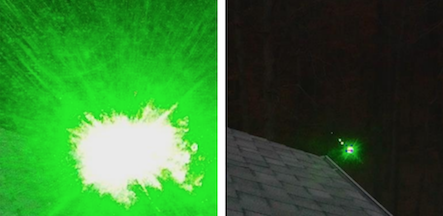
As the laser aims away from the camera, the bright center of the laser is still visible (right image, above). The system then looks at the center of the bright area to find the pixel location. Knowing the camera’s orientation, location and altitude, a Raspberry Pi computer running a Python program written by Hough calculates the approximate location. This is automatically sent via text message to pre-programmed recipients which could include law enforcement.
In ground testing on a slope, at a relatively short distance, the error was 15 meters. As the photo diagram shows, the system was successful in determining an approximate distance and location.
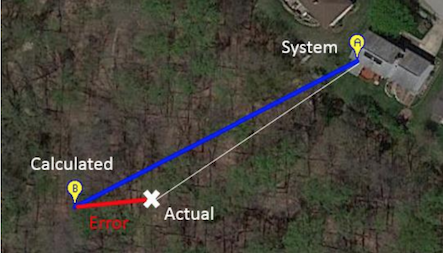
Hough notes that the system is a low-cost proof-of-concept. Suggested improvements include “more precise location sensors [that] would improve target location accuracy. Tapping into the high quality compass and GPS sensors on a commercial aircraft, for example, would drastically improve the ability of the system.” He also stated that smartphones include all the equipment needed: camera, compass, GPS, processor and display. So it should be possible to make a smartphone application to accomplish the same task.
From “Detection and Location System for Laser Interference with Aircraft”, December 2016. Thanks to Nate Hough for bringing this to our attention and allowing us to host the PDF. Note: A similar system, which does not calculate the laser source location, is the Laser Event Recorder.
Sweden: Study of 47 laser eye injury cases from 2013 to 2015
The main body of the 2015 study includes an analysis of the laser power versus the observed injuries.
The authors note “If the availability of the handheld lasers continues to increase, along with higher optical power and lower cost, we expect that the number of severe eye injuries will continue to grow. Also, the distance from which the lasers can be used to disrupt various societal functions, such as air traffic (pilots) and policing will also increase. Almost all the reported cases involve young children and teenagers. There is also a huge overrepresentation by males. Often the lasers are sold as toys and purchased by a relative as a gift to a child. Earlier reports originated almost exclusively from developed countries. This situation has now changed and more and more reports originate from developing countries. The problem is worldwide and hence there is a need to educate and inform the societies of this danger.”
The 47 new cases are listed in an appendix. Here is a random sample listing two of the cases:
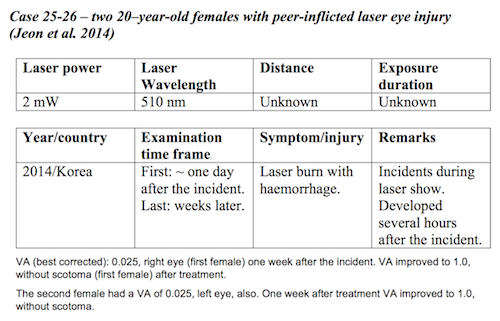
Author: Jörgen Thaung, Cesar Lopes and Stefan Löfgren
Publisher: Strål Säkerhets Myndigheten (SSM - Swedish Radiation Safety Authority)
Language: English
Publication date: December 2015
No of pages: 45
Price per publication: 100 SEK (incl. VAT)
Download: 2015:54 Retinal injuries from handheld lasers: An updated report [2200 kb]
A summary by LaserPointerSafety.com of the study’s objectives, major findings, and conclusion is here. The earlier 2013 study is summarized here and the full SSM document is available here.
US: Study examines 4 laser-caused eye injuries in children, at one medical practice
For details, see this LaserPointerSafety.com article in the non-aviation incident section of our news coverage. We are cross-referencing the article in this section as well, for persons who are looking for articles about scientific studies of laser eye injuries.
Australia: Study shows inexpensive green laser pointers are mislabled and significantly over-powered
The researchers purchased eight laser pointers from sources including electronics stores and online stores. They bought four lasers with green beams and four with red beams. The cost of each laser was less than AUD $30 (USD $23).
All of the lasers were advertised to have a maximum output power of either less than 1 mW or less than 5 mW. The green laser pointers’ actual output power measured from 51 to 127 milliwatts. Dr. Fox said “At that upper level, the beam would cause catastrophic retinal damage.”
Apparently much of the green lasers’ power was in the infrared. These types of lasers work by generating non-visible infrared light which is then converted by a crystal into visible green light. A filter is normally used to block the infrared light, and only let the green light through. However, “[t]he research team found that imported laser pointers were poorly made, with manufacturers tempted to skip installing infrared-blocking filters to hold down costs.” The researchers did not measure how much of each lasers’ output was in the visible, and how much was in the infrared.
The 127 milliwatt green laser was labeled as a Class 2 device, with maximum output power of 1 mW. In a previous study from the U.S. NIST, the highest power output they measured was 66.5 mW from a green laser labeled as having a maximum output power of 5 mW.
Three of the four red laser pointers were found to be within the legal limit of 1 milliwatt. The fourth red pointer was about 8.5 milliwatts. The researchers felt that the red lasers’ spots were less focused than green lasers, meaning there was less risk of retinal damage. Also, red lasers use diodes. The maximum power output of these diodes is limited; excessive current will destroy the diode’s lasing capacity instead of providing a more powerful beam.
The researchers noted that “Our experiment raised two very pertinent concerns – first, why were class 3B lasers so easily purchased via the internet without licensing? This suggests that there are many loopholes in the importation of these products and more stringent processes need to be reinforced. Secondly, why did green lasers labeled as Class 2 reach up to a power output of 127mW, effectively attaining a class 3B classification? It is very likely that there is a significant infrared component. This drastic degree of non-compliance suggests that there needs to be more rigorous testing and quality control of these commercially available lasers – merely imposing a power limit of less than 1mW is insufficient.”
The researchers concluded by stating that “Authorities such as the Australian Radiation Protection and Nuclear Safety Agency (ARPANSA) and medical authorities such as the Royal Australian and New Zealand College of Ophthalmologists (RANZCO) ought to advocate more strongly for stringent testing, quality control and licensing of green DPSS lasers.”
From an RMIT press release, “Over-the-counter laser pointers a threat to eyesight” and an advance copy of a paper, “Green lasers are beyond power limits mandated by safety standards,” which will be published in the Proceedings of the 2016 IEEE Engineers in Medicine and Biology Conference, online at the IEEE Xplore website. Thanks to Dr. Kate Fox for the paper.
Israel: Lasers are seen as potential terrorist tool
The laser portion of the 21-page document is four paragraphs long. The analysis appears to be sourced primarily from news accounts and public documents.
The fourth paragraph, which concludes the laser discussion, states: “Although no real damage has yet been caused by the laser threat against airplanes, the possibility cannot be ignored that terrorist organization will use laser beams against pilots in order to carry out a terror attack. This issue becomes even more significant in light of the fact that there are particularly powerful laser devices that can be found in the possession of terrorist organizations.”
Other potential aviation threats described in the document include drones, anti-aircraft missiles, recruiting disaffected airport employees, and cyber-terrorism.
The study was published by the International Institute for Counter-Terrorism (ICT) of Herzliya, Israel, a non-profit organization that calls itself “one of the leading academic institutes for counter-terrorism in the world.”
From Trends in Aviation Terrorism (PDF document)
US: Scientist uses "laser-pointer-in-a-can" to discover dinosaur eyes, feathers
In a social media post around late March 2016, Kaye posted photos of a dinosaur’s eye that is only visible with his technique.
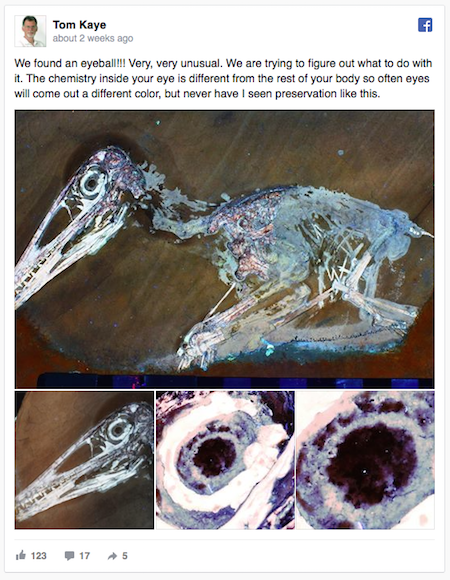
A science story notes that Kaye is “maybe the only person on Earth not named Sam Neill who can say he’s looked into the eyes of a pterosaur.”
In previous studies he used green (532 nm), blue (457 nm) and violet (407 nm) laser modules with powers from 150 to 500 milliwatts. This provides much brighter illumination of the subject. For example, a standard 20 watt ultraviolet fluorescent lamp has an irradiance (power over a given area) of 510 milliwatts per square centimeter. A 500 milliwatt (1/2 watt) laser, by comparison, provides an irradiance of around 4000 to 8000 milliwatts per square centimeter.
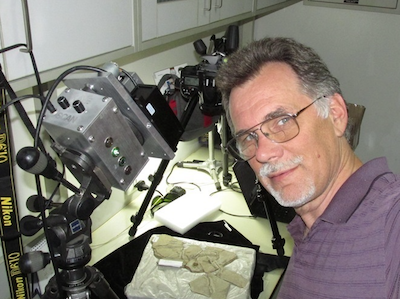
Kaye with his laser apparatus
The story “What Did Dinosaurs Look Like? Tom Kaye Finds Answers, Feathers With Lasers” appeared online at Inverse.com on April 19 2016. Inverse also featured a previous story, “Lasers Can Tell Us More About Fossils Than Before” on October 8 2015. A May 27 2015 paper by Kaye and associates, written for the online journal PLOS ONE, “Laser-Stimulated Fluorescence in Paleontology”, is here.
UK: Consumer lasers hazardous up close, but will not injure pilots, say 3 top UK experts
But in addition to this declaration, the authors also provided a succinct summary of the current state of consumer laser pointer misuse, and how ophthalmologists should proceed when studying a patient’s laser exposure.
Experts John Marshall, John O’Hagan and John Tyrer began by noting that low-powered Class 2 (less than 1 milliwatt) and Class 3R (1-5 mW) lasers “are not an eye hazard, and even if used inappropriately will not cause permanent eye damage.”
However, consumer laser devices with Class 3B (5-500 mW) and Class 4 (above 500 mW) powers have begun to cause injuries. “….[C]lass 4 devices are capable of causing irreversible retinal damage if directed into the eye over short ranges, up to several metres. Such devices have resulted in foveal injuries in children with current estimates of 150 cases in the UK. The [UK] media has given significant coverage to this growing problem.”
Ophthalmologists were advised that in cases of close up exposure, there may potentially be permanent damage. A detailed examination would be warranted, although there is no treatment to reverse permanent damage.
The hazards from this short range misuse differ from the hazards of aiming a laser towards pilots. Because the laser-to-aircraft distance is typically “hundreds to thousands of metres”, and because of scattering from the windscreen, eye injuries are nonexistent: “Fortunately, these exposures are at irradiances that are incapable of producing irreversible retinal damage even at distances of 100 m.”
They said that only one case of alleged retinal damage has been reported in pilots. [LPS.com note: this is for publicly available reports involving civilian pilots.] The experts concluded the case is suspect for a number of reasons; they do not believe laser targeting caused the alleged injury.
Marshall, O’Hagan and Tyrer turned from injuries to the hazards of distracting pilots with bright laser lights: “Obviously, if such a distraction occurs at a critical time such as during landing then the result could be devastating.”
For ophthalmologists examining pilots, if there are no permanent abnormalities on an Amsler grid test, the physician should not do any detailed eye exam, as this “would only serve to compromise the pilot's vision for a longer period.” The authors noted that pilots may delay seeing an expert for “many hours or a day or so during which there may be a growing psychological element.”
In an interview with CNN, Marshall said the findings on pilot hazards are based on previous laser safety research as well as a new study done with field experiments at a military base over about three years.
In the BJO editorial, the three experts agreed that current laser safety standards and guidelines are based on valid experiments and science. The standards do not need to be revised, “…but clearly further attempts must be made to educate the public.”
The editorial concluded “The European Commission has mandated the European Standardisation bodies to produce a standard specifically for consumer laser products. This should allow enforcing authorities to remove unsafe products from the market. However, compliance by manufacturers will remain an issue, as will direct imports by the public purchasing unsafe laser products over the internet.”
From the British Journal of Ophthalmology editorial “Eye hazards of laser ‘pointers’ in perspective” by John Marshall, John O’Hagan, and John Tyrer, available in HTML text and as a PDF document. Click on the blue “Read More…” link below for an April 19 2016 press release from the BJO summarizing the paper’s findings relative to pilot hazards.
Click to read more...
Canada: 61 pilots studied after laser exposure; no problems found
Examinations were done within three days of the strikes: “Early Treatment Diabetic Retinopathy Study visual acuity, colour vision, visual fields, intraocular pressure, slit-lamp examination, dilated fundus examination, colour fundus photographs, and ocular coherence tomography.”
The paper concluded, “Our study revealed that laser strikes on aircraft did not result in permanent visual functional or structural deficits. However, laser strikes cause immediate visual effects, including glare, flash blindness, and ocular irritation that can interfere with a pilot’s visual function.”
From the Canadian Journal of Ophthalmology, December 2015, Volume 50, Issue 6, pages 429-432. For the full abstract of the study, click the “Read More…” link.
Click to read more...
UK: UPDATED - Medical report on commercial pilot injured by blue laser at 1300 feet
“An airline pilot presented to our department complaining of a blind spot in the upper left area of his visual field in the right eye (right supero-nasal scotoma) following exposure to a laser beam while performing a landing maneuver of a commercial aircraft. At around 1300 ft (396 m), a blue laser beam from the ground directly entered his right eye, with immediate flash blindness and pain. Spectral domain ocular coherence tomography highlighted a localized area of photoreceptor disruption corresponding to a well demarcated area of hypofluorescence on fundus autofluorescence, representing a focal outer retinal laser injury. Fundus examination a fortnight later revealed a clinically identifiable lesion in the pilot’s right eye commensurate with a retinal-laser burn.”
The paper said the pilot’s symptoms “fully resolved 2 wk later” and that there was no “deficit in visual function.”
Click to read more...
US: Study of U.S. incidents, 2010-2014 gives insights into laser-aircraft safety
An AirSafe summary noted that from 2010 through 2014, there were only eight days with no laser encounters reported in the U.S. The graph below shows the distribution of incidents, with most days having between 7-12 laser strikes:
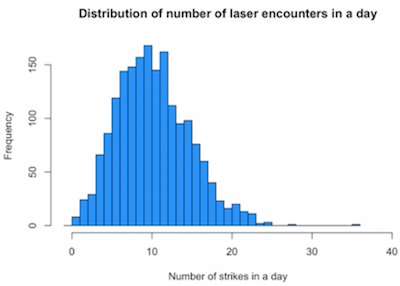
Analysis by day of the week, and by month of the year, showed Friday and Saturday evenings as having a greater likelihood of illuminations. July through November saw higher-than-normal numbers of incidents.
The AirSafe study also looked at six selected metropolitan areas. It compared the number of flights to the number of incidents. Phoenix, Los Angeles and San Francisco had higher-than-normal numbers of incidents; Chicago and New York were about average, and Atlanta was below average.
From AirSafe.com: summary page, and detailed analysis as a webpage, PDF and RPubs versions. Links are given to the raw FAA data, the processed version used by AirSafe, and statistical R code. Thanks to Dr. Todd Curtis who did the study and brought this to our attention.
US: Doctors warn laser eye injuries may be misdiagnosed as genetic disorders
Such misdiagnosis has medical and financial consequences from the additional diagnostic workups and DNA sequencing used to detect hereditary genetic disorders such as rod monochromatism, Stargardt disease and occult macular dystrophy.
In addition, the paper describes five cases of where children using laser pointers experienced blurry vision and had eye injuries. “In some cases, the vision was as poor as 20/80, which is bad enough to fail a driving test,” said researcher Dr. Stephen Tsang, who is affiliated with Columbia University and NewYork-Presbyterian Hospital.
Dr. Tsang and his colleagues noted damage patterns similar to tree branches on the children’s retinas:

They suggest that eye-care professionals should ask patients with such patterns if they have been using lasers. Because children may be hesitant to talk in front of their parents, the researchers also suggest talking to a child alone.
A Columbia University press release noted “Since the publication about the five patients, the researchers have seen several more children with laser-induced eye injuries, suggesting that these cases are not isolated phenomena.”
From Columbia University Medical Center Newsroom, Nov. 5 2015. The Ophthalmic Genetics article “Laser induced photic injury phenocopies macular dystrophy” is not yet online as of this date, but can be found at the journal’s website.
Saudi Arabia: Handheld blue-light lasers can cause macular hole in retina
The study, reported in the July 2015 American Journal of Ophthalmology, looked at 17 eyes of 17 patients at two institutions, between January 2012 and May 2014. Most were youths (mean patient age 18 years; range: 11 to 30 years old). The eyes were exposed to blue laser light for less than one second, at a mean distance estimated to be about 1 meter from the laser. The time from exposure to the patient visiting the hospital for treatment ranged from two days, to almost 500 days.
Patients were given a full ophthalmic examination, including fundus photography, macular spectral-domain optical coherence tomography, and fundus fluorescein angiography.
The macular holes ranged from 0.17 millimeters to 0.62 mm, with a mean diameter of 0.35 mm.
In 14 of the eyes, surgeons went deep into the eye and removed vitreous gel (a pars plana vitrectomy); this removes clouded gel that may contain blood from the injury. At the same time surgeons also did a procedure called “internal limiting membrane peeling,” which uses an instrument to make a break in the membrane which is then peeled away with forceps.
In 11 of the 14 eyes, the operation completely closed the macular hole. Of the other three unoperated eyes, the eye with the smallest macular hole spontaneously closed.
Before the operation, the mean Snellen best corrected visual acuity (BCVA) was 20/210, or about 1/10th the normal visual acuity; the range was from 20/30 to 2/200. After the operations, the mean BCVA was 20/62 (range: 20/20 to 4/200). These statistics included all eyes (the 14 operated eyes and the three unoperated ones).
The authors concluded “Full-thickness MH can result from momentary exposure to high-power handheld laser devices. While spontaneous closure may occur in rare cases, most cases require early surgical intervention. Vitrectomy may be successful in closing the macular hole with visual acuity improvement in most of the cases.”
From the abstract of the study by Alsulaiman SM, et al., “Full-Thickness Macular Hole Secondary to High-Power Handheld Blue Laser: Natural History and Management Outcomes” in the American Journal of Ophthalmology, July 2015 Vol. 160, Issue 1, Pages 107-113.e1.
Note: Other studies have been published based on this data, an August 2013 LaserPointerSafety.com story about the first study is here.
US: Study shows windscreen coatings can reduce laser intensity
More information at the LaserPointerSafety.com page on the 2015 Nanocomposite coating study
Sweden: Detailed study released of worldwide laser pointer eye injuries
“The purpose of this study was to investigate what dose of laser radiation, in terms of intensity and exposure time, may be associated with eye damages. The study has been limited to unwanted exposures of laser radiation from commercially available laser pointers. Of particular interest has been to search for data that clarify the dose-response relationships for functional disabilities that persist more than 6 months.”
“The study shows that long-term vision loss can occur as a result of involuntary exposure from commercially available (strong) laser pointers at close range. The injury may occur before a normal person is able to respond by closing the eyelid, although there are only a few cases reported. A minor such damage is transient within a few days. It is also likely that such a visible injury to the retina becomes functional, i.e. prevents reading skills. What dosage is required for the disability to become permanent is not clear in the literature. Also, the dynamics of evolvement and repair of tissue damages and disabilities are hardly described at all.”
Author: Stefan Löfgren, Jörgen Thaung and Cesar Lopes
Publisher: Strål Säkerhets Myndigheten (SSM - Swedish Radiation Safety Authority)
Language: English
Publication date: 19 November 2013
No of pages: 50
Price per publication: 100 SEK (incl. VAT)
Download: 2013:30 Laser pointers and Eye injuries - An analysis of reported cases [1385 kb]
A summary by LaserPointerSafety.com of the study’s objectives, major findings, and conclusion is here.
UPDATED January 2016: The SSM released an update, with 47 additional cases worldwide of eye injuries from consumer lasers. A summary by LaserPointerSafety.com is here; the full SSM document is here.
World: Summary of papers presented at International Laser Safety Conference 2013
Laser pointer hazards for pilots
- A study of the actual output of 40 laser pointers, with powers up to 1.5 Watts, showed significant differences between measured and calculated hazard levels. In some cases, the actual hazard measured at some spots inside the beam was three times the estimated hazard. This is due to the laser output not being smooth in all cases, but instead the beams having “hot spots”. The study also showed that windscreens reduced the beam irradiance -- which is safer for pilots -- from 5% to 60%. (Note however that the McLin study described below showed that windscreens also spread the beam and thus increase glare.)
- A discussion of how being inside the Nominal Ocular Hazard Distance of a laser beam does NOT mean instant blindness for pilots and others.For example, consider a 1 Watt, 1 milliradian laser where the recommended safety distance (NOHD) is 733 feet. If possible, you should be at least 733 feet from the laser before exposing an eye to the direct beam. What is the actual hazard? At 232 feet from this laser, there is a 50/50 chance of the beam causing a barely observable retinal lesion under laboratory conditions where the laser and eye are fixed in place. Due to motion of the aircraft and hand-holding the laser, the chance of a retinal lesion is likely to be less. The distance from 232 feet (“ED50”) out to the NOHD at 733 feet is a known “safety factor” where the chance of retinal injury decreases even further. At the NOHD there is a “vanishingly small risk of hazardous exposure” (Sliney, 2013). Police and other first responder pilots can use this information to better weigh the risk of laser exposure to laser light vs. the benefits of completing a mission (rescuing a person, apprehending criminals, etc.). This presentation also discusses ways to make flight near lasers safer for pilots. A PDF file of all the slides presented is here.
For additional ILSC 2013 papers, click the “read more” link.
Click to read more...
US: Government agency finds most laser pointers they purchased are overpowered
The findings were made public at a March 20 2013 meeting of the International Laser Safety Conference.
Researcher Joshua Hadler designed the measurement device to be accurate, inexpensive and easy-to-use. It would cost roughly $2000 in equipment costs to make a copy of the NIST device; plans are available from NIST for interested parties.
From a NIST press release, March 20 2013.
Click here for the full press release:Click to read more...
Australia: Ban on laser pointers has been a "detriment" to safety
The author, Trevor Wheatley, is chair of the Standards Australia SF-019 Committee on laser safety. He studied 41 lasers purchased online in 2012 that were claimed by the sellers to be legal -- lower than the Australian import limit of 1 milliwatt. Most cost less than AUS $20.
Wheatley found that 95% of these pointers were illegal under Australian law, with outputs above 1 mW. Of the 41, 78% were between 5 mW and 100 mW. (5 mW is generally taken to be the highest safe power for a general purpose laser pointer.)
Based on Wheatley's research, "...there would appear to be a greater than 50% chance that someone attempting to buy a 'safe' laser pointer would inadvertently get a hazardous laser." Further, 100% of the tested laser pointers below $20 "would represent prohibited weapons in most Australian states."
From other statistics, the paper states that "availability has not been significantly impacted." In 2007/2008 there were 648 incidents involving lasers pointed at aircraft. In 2010/2011, well after the import and possession restrictions, the number of incidents had increased to 828.
Click to read more...